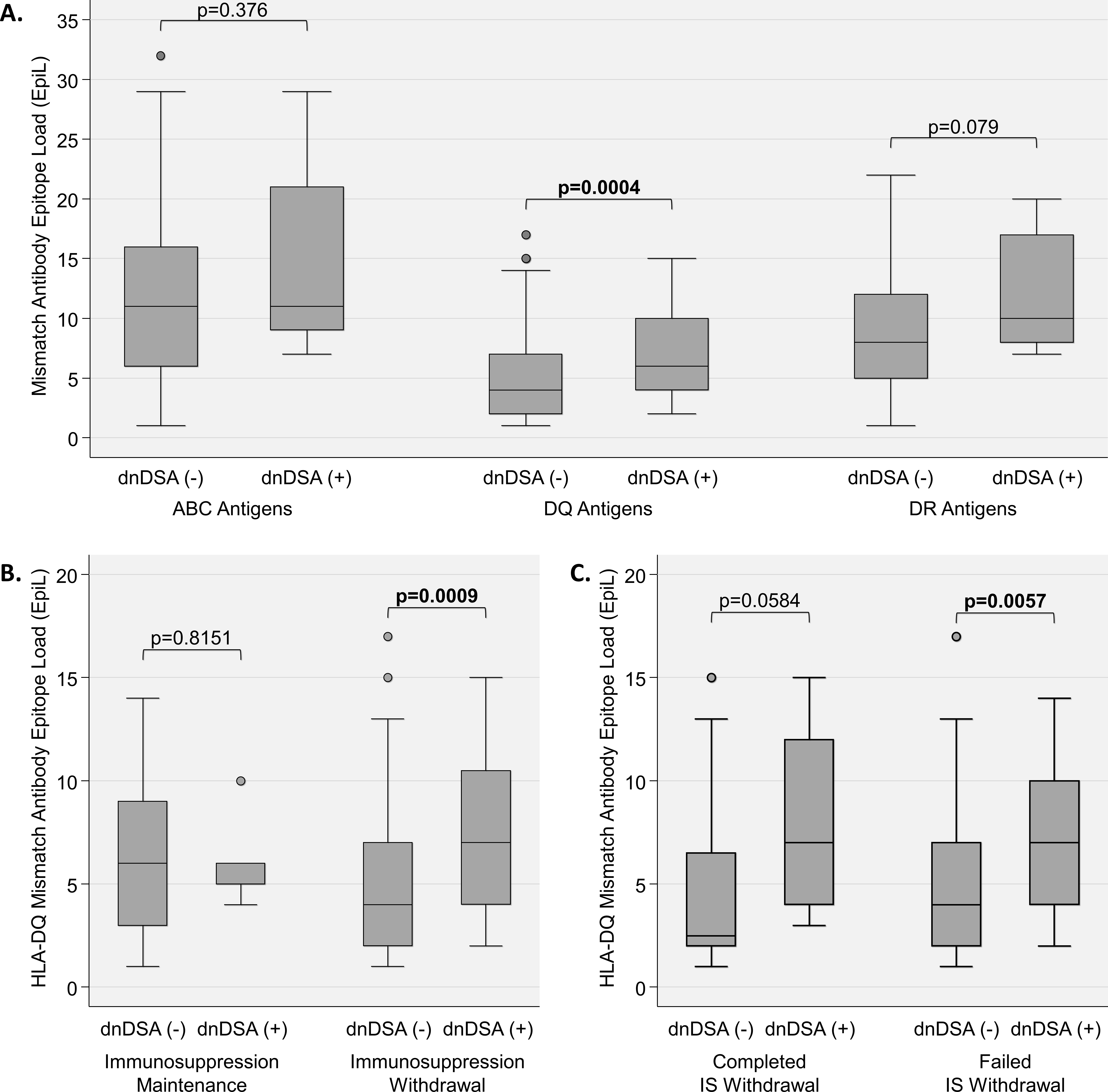Mismatched Antibody Epitopes and the Development of HLA-DQ De Novo DSA during Immunosuppression Withdrawal in Liver Transplant Recipients
1Terasaki Research Institute, Los Angeles, CA, 2University of Pennsylvania, Philadelphia, PA, 3Immune Tolerance Network, San Francisco, CA, 4University of California San Francisco, San Francisco, CA, 5Northern Western University, Chicago, IL
Meeting: 2019 American Transplant Congress
Abstract number: D355
Keywords: Epitopes, HLA antibodies, Liver transplantation, Tolerance
Session Information
Session Name: Poster Session D: Tolerance: Clinical Studies
Session Type: Poster Session
Date: Tuesday, June 4, 2019
Session Time: 6:00pm-7:00pm
 Presentation Time: 6:00pm-7:00pm
Presentation Time: 6:00pm-7:00pm
Location: Hall C & D
*Purpose: We recently described, in liver transplant (LT) recipients from the ITN030ST study, the development of de novo donor-specific HLA antibodies (dnDSA) and their impact on allograft outcomes before, during and after immunosuppression (IS) withdrawal. Since dnDSA target epitopes rather than whole antigens, and dnDSA development is associated with the mismatched HLA antibody epitope load (EpiL), we investigated whether the EpiL of HLA mismatches (MM) was associated with dnDSA development, particularly during IS withdrawal.
*Methods: We studied a subgroup of 69 LT recipients from the ITN030ST study selected based on available high resolution typing for HLA-A, -B, -C, -DR and -DQ loci of donor-recipient pairs. Of the 69, 40 stable subjects were randomized to IS maintenance (n=9) or IS withdrawal (n=31). Among the latter, 9 subjects were off IS completely. LabScreen single antigen beads were used for dnDSA screening. We used E3 – an epitope analysis software – to estimate the EpiL of a donor-recipient pair and to characterize epitope-specific dnDSA.
*Results: We studied 762 HLA MM in 69 subjects (11 ± 2.1 MM/subject), of which 63 MM induced an epitope-specific dnDSA. Among the MM with Epil>0 (n=657), DQ MM that induced a dnDSA had a significantly higher EpiL compared to DQ MM that did not induce a dnDSA (p=0.0004), but there was no statistical difference in the EpiL of A/B/C and DR MM that induced a dnDSA and the ones that did not (Figure 1A). In the IS maintenance arm, there was no statistical difference in the EpiL of DQ MM that induced a dnDSA and the ones that did not, whereas in the IS withdrawal arm, DQ MM that induced a dnDSA had a significantly higher EpiL compared to DQ MM that did not induce a dnDSA (p=0.0009) (Figure 1B). However, there no statistical difference in the EpiL of DQ MM that induced a dnDSA and the ones that did not in the subjects off IS completely, but in the subject that failed IS withdrawal, the DQ MM that induced a dnDSA had a significantly higher EpiL compared to the DQ MM that did not induce a dnDSA (p=0.0057) (Figure 1C).
*Conclusions: Overall, the development of DQ dnDSA is associated with the DQ EpiL, particularly during IS withdrawal. However, this association is not seen in IS maintenance and in patients off IS. Further studies are required to determine whether DQ MM EpiL can predict DQ dnDSA development during IS withdrawal.
To cite this abstract in AMA style:
Jucaud V, Shaked A, DesMarais M, Sayre P, Feng S, Levitsky J, Everly M. Mismatched Antibody Epitopes and the Development of HLA-DQ De Novo DSA during Immunosuppression Withdrawal in Liver Transplant Recipients [abstract]. Am J Transplant. 2019; 19 (suppl 3). https://atcmeetingabstracts.com/abstract/mismatched-antibody-epitopes-and-the-development-of-hla-dq-de-novo-dsa-during-immunosuppression-withdrawal-in-liver-transplant-recipients/. Accessed December 17, 2025.« Back to 2019 American Transplant Congress

